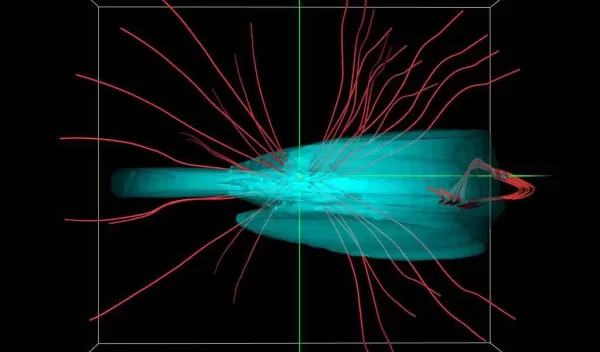
Taking the "Surprise" out of Surprise Solar Storms
From Sept. 1 to 2, 1859, the sun blasted out a massive, record-breaking coronal mass ejection (CME)--a huge eruption of highly charged gases and plasma that may have weighed as much as a billion tons. Racing through the solar system at several million miles per hour, the CME eventually collided with the Earth's magnetosphere--an invisible, atmospheric cocoon surrounding the planet that is filled with charged particles controlled by the Earth's magnetic field.
Hit by the CME, the Earth's magnetosphere temporarily went into a haywire state known as a geomagnetic storm. The result: skies were set ablaze all over the world with technicolor auroras that reached as far south as Cuba and El Salvador, and blew out global telegraph systems, the highest-tech communication devices of the day.
The 1859 geomagnetic storm, called the Carrington Storm, was the largest geomagnetic storm ever recorded. "But there is absolutely no reason why the Earth couldn't be hit by an equally or even more violent geomagnetic storm today, tomorrow, or the next day," said Sarah Gibson of the National Center for Atmospheric Research (NCAR) in Boulder, Colo.
Because the Carrington storm occurred during relatively low-tech times, the havoc it unleashed provided but a tame preview of what would happen if a contemporary Carrington-like storm were to hit our technology-dependent society. In fact, according to a report by the National Academy of Sciences, a contemporary Carrington-like storm could trigger cascading catastrophes, including melted transformers that could shut down large, interconnected power grids, power outages affecting as many as 130 million people, backed-up sewage systems, the failure of electronic transportation systems, and the collapse of systems used to distribute drinking water, food, medicines and fuel.
But a geomagnetic storm would not even have to reach Carrington's record-breaking strength to cause serious damage. In recent years, weaker geomagnetic storms have damaged technological systems like satellites, increased the radiation exposure of astronauts, disrupted communication and navigation systems and knocked out power to large populations.
CMEs are associated with peaks in the activity of sunspots, which are knots of magnetism on the sun's surface generated by subsurface movements of solar material. (Sunspots appear dark because they are cooler and therefore less bright than their hotter surroundings.) Sunspot activity peaks about every 11 years; this 11-year cycle is, in turn, related to a 22-year cycle of reversals in the sun's magnetic field.
During a typical 11-year sunspot cycle, the sun hurls about 100 severe CMEs and about four extreme CMEs into the solar system--only a fraction of which usually hit the Earth. Such CMEs are most likely to occur during peaks in sunspot activity, and are less likely to occur during periods of low sunspot activity.
"But," warns Gibson, "CMEs still occur during periods of low sunspot activity; but they are just fewer and further between than during active sunspot periods. And so it is still very possible for a fierce geomagnetic storm to occur during a solar minimum."
Because scientists vigilantly watch for CMEs through high-tech telescopes and because it usually takes two or three days for most of a CME's impacts to reach the Earth, scientists can anticipate geomagnetic storms once Earth-directed CMEs start. Nevertheless, scientists cannot yet forecast when CMEs will start.
With funding from the National Science Foundation, scientists at NCAR are currently using various methods to improve their understanding of CMEs and their ability to forecast them. Among these methods are computer simulations of CMEs that describe their physical properties based on conditions on the sun and Earth and the laws of magnetism, electricity, gravity and thermodynamics--as shown in the above image and an animated simulation of a CME.
Some simulations are based on hypothetical data that is designed to reflect typical solar events. But other simulations are based on specific data collected on a particular day and are designed to recreate actual CMEs. Data incorporated into such simulations may include, for example, the Earth's position relative to the sun during the CME; the mass, composition, size and electrical charge of the CME; and conditions immediately around the Earth upon the CME's arrival. By comparing their simulation with direct observations of the real-life CME it was designed to recreate, scientists can evaluate their simulation's accuracy and improve it.
This Discovery article was previously provided to LiveScience in partnership with the National Science Foundation.


